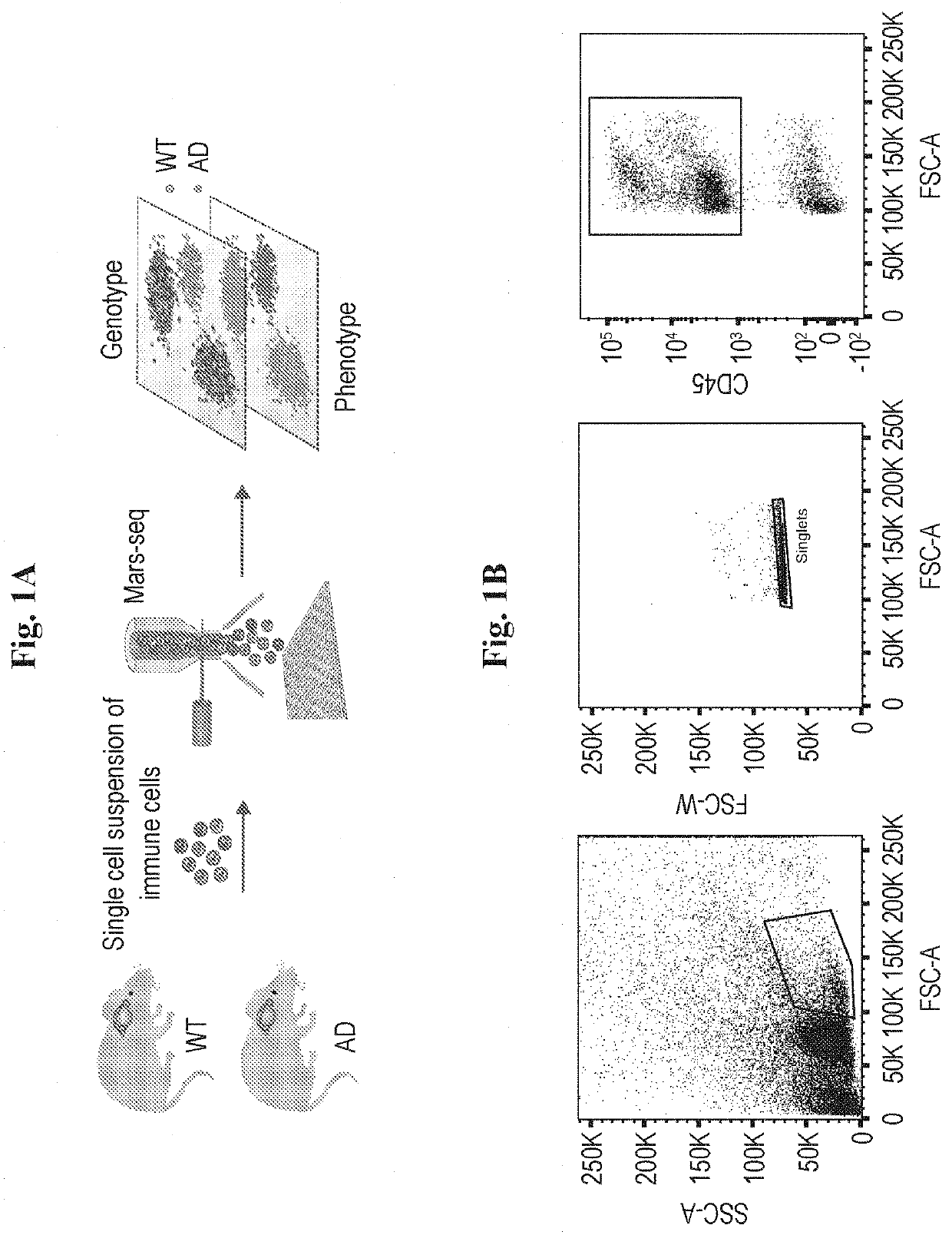Methods of treating neurodegenerative diseases by inducing disease-associated microglia (DAM) cells
a neurodegenerative disease and microglia technology, applied in the field of neurodegenerative diseases, can solve the problems of insufficient microglial function in neurodegenerative diseases, limited resolving the heterogeneity, niche specificity and complexity of immune cell types within the cns, and methods that are counterproductive,
- Summary
- Abstract
- Description
- Claims
- Application Information
AI Technical Summary
Benefits of technology
Problems solved by technology
Method used
Image
Examples
example 1
ation of a Unique Microglia Type Associated with ALZHEIMER DISEASE
[0102]Current characterization of immune cells involved in AD has been obtained from populations sorted according to a small set of canonical cell surface markers. Therefore, the observed gene expression signatures may obscure the presence of additional immune cell types, and overlook the composite picture of related and dynamic subsets in the brain. To de novo characterize the immune cell types and states involved in AD, we first sorted all immune cells (CD45+) from brains of 5XFAD, a commonly used AD transgenic mouse model that expresses five human familial AD gene mutations, compared with age and sex matched wild type controls, and performed massively parallel single-cell RNA-seq (MARS-seq; (28)) (FIGS. 1A, B). In order to link between the canonical surface markers to the genome wide expression profiles, we used an index sorting strategy that allowed for retrospective analysis of surface marker combinations of each...
example 2
ssociated Microglia Dynamics During AD Progression
[0104]AD is a progressive disease with gradual increase in neuronal death and loss of cognitive function. Identifying the relevant changes in DAM regulation along the course of the disease could shed light on the molecular mechanisms of DAM regulation and potentially suggest of new therapeutic targets. AD typically progresses in three general stages; early-stage, mild-moderate, and severe. In the 5XFAD AD model these stages are accelerated and high levels of intraneuronal aggregated (3-amyloid start to appear at around 1.5 months of age and amyloid and plaque deposition at 2-3 months of age. Neuronal loss and deficits in spatial learning initiate at around 6 months and severe cognitive dysfunction is observed at 7-8 months of age. We therefore performed single cell RNA-seq in whole brains of 5XFAD mice at 1, 3, 6 and 8 months of age.
[0105]In order to enrich for the rare DAM cells over other immune populations, we used the single cell...
example 3
ocalized Near AD Plaques
[0107]Our single cell analyses were obtained from immune cells isolated from whole brains including the meninges and parenchyma of AD involved (e.g. Cortex) and uninvolved (e.g. Cerebellum) brain regions. In order to spatially orient the immune cell compositions within different brain regions we repeated the single cell sorting experiments on dissected cortex and cerebellum of 6-month old AD and wild type mice and compared the immune composition of these two regions using single cell RNA-seq of all immune (CD45+) cells. Analyzing 6347 cells from four AD and wild type mice, we found that DAM are located within the cortex, but not the cerebellum of AD mice (FIGS. 3A-B, 3I). Using the rich molecular characteristics of DAM we further performed immunohistochemistry staining and single molecule fluorescence in situ hybridization (smFISH). We focused on differentially expressed DAM markers and anti-Aβ plaque labeling. Cortex staining for IBA-1, a classical homeostat...
PUM
 Login to View More
Login to View More Abstract
Description
Claims
Application Information
 Login to View More
Login to View More - R&D
- Intellectual Property
- Life Sciences
- Materials
- Tech Scout
- Unparalleled Data Quality
- Higher Quality Content
- 60% Fewer Hallucinations
Browse by: Latest US Patents, China's latest patents, Technical Efficacy Thesaurus, Application Domain, Technology Topic, Popular Technical Reports.
© 2025 PatSnap. All rights reserved.Legal|Privacy policy|Modern Slavery Act Transparency Statement|Sitemap|About US| Contact US: help@patsnap.com



